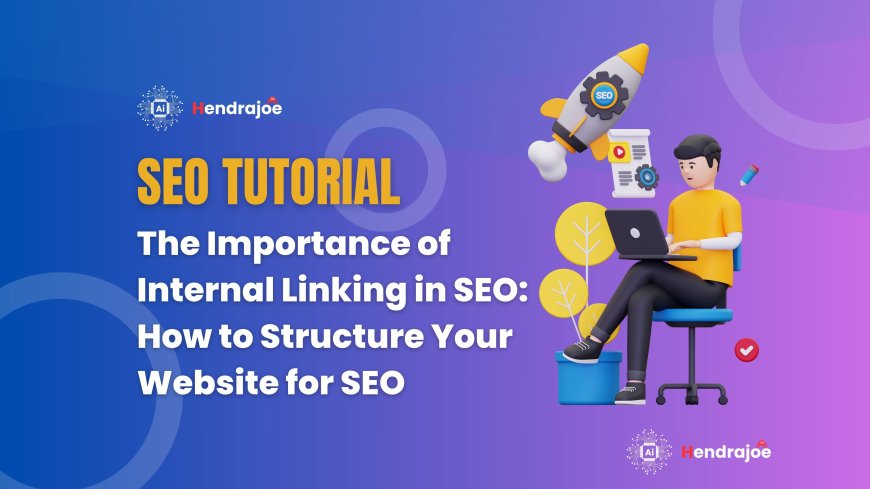The Importance of Internal Linking in SEO: How to Structure Your Website for SEO
Discover the importance of internal linking for SEO. Learn how to structure your website, use internal links effectively, and boost your rankings with these SEO best practices

When it comes to SEO (Search Engine Optimization), most people focus on external factors like backlinks and content optimization. However, one of the most underrated yet powerful tools in SEO is internal linking. Internal links are the links that connect one page of your website to another, and they play a crucial role in helping search engines and users navigate your website.
In this article, we’ll discuss why internal linking is so important for SEO, how to structure your website for better internal linking, and the best practices for using internal links to boost your search engine rankings.
1. What is Internal Linking?
Internal linking refers to the practice of linking one page of your website to another page on the same website. Unlike external links, which point to other websites, internal links help create a network of pages within your own site.
These links can be placed in a variety of areas on your site, including:
- Navigation menus
- Blog posts
- Footer links
- Sidebar widgets
The primary goal of internal linking is to guide visitors to relevant content, making it easier for them to find information, stay longer on your site, and improve your overall user experience.
2. Why is Internal Linking Important for SEO?
1. Helps Search Engines Crawl Your Site
One of the most important roles internal links play in SEO is helping search engines crawl and index your website. When search engines like Google crawl your website, they follow links to discover new pages. Internal links help search engines understand the hierarchy of your site and how your pages are related.
By ensuring that your internal links are set up properly, you make it easier for search engines to discover and index all the pages on your site, which can help boost your rankings. Without effective internal linking, search engines may overlook or fail to index important pages on your site.
2. Distributes Page Authority (Link Juice)
Internal links help distribute page authority (often referred to as "link juice") throughout your website. When you link from a high-authority page to a lower-authority page, you can pass some of that authority, helping to improve the rankings of the linked page. This process can help pages that are buried deeper within your site gain more visibility.
For example, if you have a high-ranking blog post, linking to other relevant posts on your website can help those pages rank better over time, increasing the overall SEO performance of your site.
3. Improves User Experience and Engagement
Internal linking is not only good for SEO but also for the user experience (UX). By strategically linking to related content, you encourage users to explore more of your website. This increases the amount of time they spend on your site, reducing bounce rates, and improving engagement metrics—all of which are factors that Google takes into account when ranking your website.
Internal links also provide easy access to content that users might not have found otherwise. For example, if you have a blog post that’s related to another topic, internal linking can guide users to more in-depth information, keeping them engaged and encouraging them to read more.
4. Boosts Your Site's Content Hierarchy and Structure
By using internal linking effectively, you can help establish a clear content hierarchy on your website. This means search engines and users will be able to easily identify your most important pages.
For example:
- The Homepage usually carries the most link authority because it's linked from almost every other page on your website.
- Category Pages typically contain the most relevant content for a specific topic.
- Blog Posts and Product Pages provide more detailed information about a specific topic.
When you use internal links wisely, you help search engines understand the structure of your site and how each page fits into the bigger picture.
3. How to Structure Your Website for SEO with Internal Linking
Now that we’ve established why internal linking is important, let’s discuss how to structure your website to make the most of internal links.
1. Create a Clear Site Hierarchy
A clear site structure is essential for both SEO and user experience. The easier it is for both users and search engines to navigate your site, the better your rankings will be. Here are some best practices for structuring your site:
- Homepage: Your homepage should serve as the central hub of your website, linking to all important categories and pages.
- Category Pages: These pages should group content by topic. For example, if you run an e-commerce site, category pages might include “Men’s Clothing,” “Women’s Clothing,” or “Accessories.”
- Content Pages: Blog posts, product pages, and landing pages should be linked from category pages and, where appropriate, linked to each other.
Use breadcrumb navigation to provide users with an easy way to understand their location on your website. For example, a breadcrumb trail for a blog post might look like this: Home > Blog > How to Use Internal Linking for SEO
This makes it easier for both users and search engines to understand the relationship between pages.
2. Use Contextual Linking
Contextual links are links embedded in the content of a page, such as blog posts or articles. This is one of the most powerful ways to use internal linking because it connects related content naturally within the text.
For example, if you’re writing a blog post about SEO, you can link to other related posts like “How to Improve Your Site’s Speed for Better SEO” or “Keyword Research Best Practices.”
When using contextual links, it’s essential to:
- Use anchor text that accurately describes the linked page’s content.
- Link to relevant and high-quality pages that add value to your content.
- Avoid over-linking, as too many links can make the content feel cluttered and spammy.
3. Make Use of Footer and Navigation Links
While contextual links are the most powerful form of internal linking, don’t overlook the value of links in your website’s footer or main navigation. These areas are highly visible to both users and search engines.
- Footer Links: Use the footer of your website to link to important pages such as your contact page, about us page, privacy policy, and top blog posts.
- Navigation Links: Your site’s main navigation menu should provide clear access to your most important pages, categories, and sections.
However, don’t overdo it. Only include links to important, high-value pages in your navigation and footer sections. Too many links can overwhelm users and make your site look spammy.
4. Use a Logical URL Structure
A well-organized URL structure also contributes to your website’s overall SEO. The URL should reflect the hierarchy of your site and make it clear to both users and search engines where the page fits into the structure.
For example:
- https://example.com/blog/how-to-use-internal-linking is a clear, logical URL.
- https://example.com/5436hjdsl23lkd is a poor URL structure and doesn’t provide any useful information.
4. Best Practices for Internal Linking
To get the most out of your internal linking efforts, here are some best practices to follow:
1. Use Descriptive Anchor Text
Anchor text is the clickable text that appears in a hyperlink. Use descriptive anchor text that gives users (and search engines) an idea of what the linked page is about. For example, instead of using generic anchor text like “click here,” use specific text like “learn more about internal linking best practices.”
2. Keep Your Links Relevant
Always ensure that the links you include are relevant to the content. Linking to pages that are completely unrelated can confuse users and may harm your SEO.
3. Link to Older Posts and Pages
While it’s important to link to new content, don’t forget about older content. Linking to older blog posts or pages can help revitalize that content and ensure that it continues to get traffic and rankings.
4. Monitor and Update Links Regularly
Occasionally check your internal links to make sure they are still relevant, functional, and leading to high-quality pages. Broken links can harm your SEO and user experience, so fix them as soon as possible.
5. Conclusion
Internal linking is one of the most effective ways to improve your website’s SEO. By creating a well-structured site, using contextual links, and distributing page authority across your website, you can improve both your search engine rankings and your user experience.
A strategic internal linking strategy not only helps search engines crawl and index your site more effectively, but it also keeps visitors engaged by guiding them to relevant content. By following the best practices outlined in this guide, you can ensure that your internal linking efforts contribute to your website’s overall SEO success.
What's Your Reaction?









































